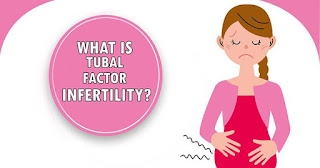Tubal Factor Infertility - by Dr Ankita Kaushal
Tubal Factor Infertility :
Why are fallopian tubes important?
Fallopian tubes are hollow muscular tubes,
inside they are lined by hair-like bristles, they originate from the uterine
cavity and end on top of ovaries. There are 2 fallopian tubes one on each side.
The ovarian end has finger-like structures that help to suck in the egg in the
tube after ovulation. The sperms swim from the vaginal cavity into the uterine
cavity to the tubes. The egg is fertilized by the sperms in the tubes. This is
where embryo forms and starts to develop further. After few days of development
in the tubes, the embryo is shifted to the uterine cavity where it implants
after which you are pregnant.
In case of any kind of damage to the
fallopian tubes, the sperms will not reach the egg for fertilization, the
embryo might not form, the embryo might not survive in damaged tubes.
For all of the above to happen and pregnancy to
occur, PATENT AND FUNCTIONAL FALLOPIAN TUBES ARE MOST IMPORTANT.
What damage can happen to the tubes?
1.
One or both tubes can be
blocked.
Tubes can be
blocked at the point of origin from the uterus (proximal block or cornual
block) in which case sperms will not be able to reach the egg and fertilization
will not happen.
Tubes can be
blocked at the fimbrial end (near the ovaries). In this case, fluid can get
accumulated in the tubes, which might drain in the uterine cavity and hamper
implantation of the embryo (in case of IVF/ICSI).
2.
Tubal scarring due to previous
surgeries (ruptured appendix, ruptured ectopic pregnancy, ovarian torsion,
ruptured ovarian cyst, endometriosis.)
3.
Disturbed tubal anatomy (
adhesions due to pelvic infections , endometriosis, previous surgeries, pelvic
tuberculosis).
4.
Kinking of the tubes due to
adhesions.
What are
the causes of Tubal damage? :
1.
Infections : pelvic infections;
sexually transmitted diseases such as chlamydia, gonorrhoea; pelvic
tuberculosis.
2.
Endometriosis .
3.
Ruptured Ectopic pregnancy. (
affected tube is removed)
4.
Previous surgeries for ruptured
appendix, ovarian cyst, endometriosis, ectopic pregnancy.
5.
History of Tubal ligation
How to diagnose tubal problem ?
Tubes are usually checked only when a
couple is evaluated for infertility. It is commonly found in younger age
groups.
1.
HYSTEROSALPINGOGRAM: a dye is
passed through your uterus, if tubes are open, passes through the tubes and
leaks into the pelvis. X RAY films are taken at 0, 5 and 10 minutes to record
presence/ absence of dye in the tubes and leaking into the pelvis. Done on OPD
basis, no anesthesia required.
2.
SONOSALPINGOGRAPHY: sterile
normal saline is passed through the uterine cavity with the help of a flexible
catheter. On sonography presence of saline (water) is seen below the uterus,
suggesting the either one or both tubes are open and that is how saline leaked
into the pelvic cavity. It is an OPD procedure, no anesthesia required.
3.
HIGH CONTRAST
SONOSALPINGOGRAPHY: same as sonosalpingography, but in place of normal saline,
contrast is passed which is visible on sonography. It is an opd procedure, no
anesthesia required.
4.
LAPAROSCOPY AND
CHROMOPERTUBATION: a laparoscope is inserted in the lower part of the tummy.
Methylene blue dye Is passed into the uterus and is documented under direct
vision if tubes are open ( dye flows out) or blocked ( dye does not flow out).
This is gold standard for diagnosis of blocked tubes. It requires anestheia and
hospital admission.
What is
other diagnosis , If tubes are not blocked ?
1.
Tubal muscle spasm ( cornual ,
fimbrial) : Sometimes due to mild pelvic infections or any other reasons, the
two open points of the tubes ( uterine end and ovarian end) can go into spasm.
This can give a blocked tube like of picture on HSG/SSG/HYCOSY. Only on
laprascopic evaluation, if the dye id pushed forcefully, it might relieve the
muscle spasm and tubes will be patent and functional.
2.
Thin adhesions : Due to some
other pathology or previous surgery, thin flimsy adhesions form that might
cause kinking of tubes, giving an impression of blocked tubes. On laprascopic
evaluation, once the adhesions are removed, tubes become patent and functional.
How to treat blocked tubes?
1.
If tubes are normal in
structure and are blocked due to other problems ( tubal muscle spasm, thin
adhesions) once the correction is done, tubal function is restored.
2.
If tubes are blocked but there
are no signs of any other pathology, tubal recannulation can be done to relieve
muscle spasm. This will restore functional capacity of the tubes. Tubes can get
blocked after this also. This also might increase chances of Ectopic pregnancy.
3.
If the tubal pathology is
severe ( bilateral block, tuberculosis, hydrosalpinx, endometriosis), ASSISTED
REPRODUCTIVE TECHNIQUES (IVF/ICSI) give better chances of achieving pregnancy.
4.
In case of hydrosalpinx ( fluid
filled in tubes) or pyosalpinx (pus filled in tubes), it might drain into the
uterine cavity decreasing the chances of implantation of embryo. In such
situations, removal of affected tube/tubes or clipping of tube/tubes should be
done, to increase chances of pregnancy following embryo transfer.
For more information contact
9136875667/ 02227714482.



If you want reasonable cost infertility treatment then Sofat Infertility & Women Care Centre is the best option for you. You can consult with our experienced gynecologist at our Test Tube Baby Centre in Punjab. Check our website and get further information on IVF Treatment.
ReplyDeleteFor many couples who are having problems conceiving, artificial insemination is the answer to becoming pregnant and having a child .thank you for your blog.
ReplyDeleteBest fertility centre in Chennai
Best ivf centre in Chennai
Chennai fertility Center
nice post..
ReplyDeletebest gynaecologist in anna nagar chennai
best fertility doctor in Chennai
top gynecologist in chennai
thanks for sharing this article, now see more results in this video of Best IVF Centre in Punjab
ReplyDelete